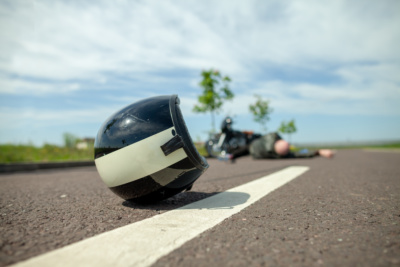The National Highway and Traffic Safety Administration estimates that nearly 100,000 people a year are injured in motorcycle accidents. Road rash is one of the most common injuries suffered in a motorcycle accident.
According to the National Highway and Traffic Safety Administration (NHTSA), nearly 90 percent of motorcycle injuries result in road rash. A rider can suffer from road rash when they slide along the road after falling off the motorcycle in an accident. There are ways to prevent the risk of road rash by wearing proper gear (like specialty suits and leather jackets), but it is still possible you may get road rash if you are in a motorcycle accident. Road rash is a very serious injury that riders should treat immediately.
Road rash injuries are ranked in three “degrees” from mild to severe as follows:
-First Degree (minor) – This can include small scrapes, redness, bruising, slight bleeding and tenderness. Most minor cases can be treated at home by cleaning the area well.
-Second Degree (serious) – This can include radiating heat, swelling, bleeding, exposed tendons, muscle, or nerves. This type of road rash is often painful to the touch. You will want to keep the wound clean and seek medical attention immediately. A common side effect of this type of road rash is scarring.
-Third Degree (severe) – This can include exposed muscle, tendons, bone, or nerves and the wound can cover more than 10 percent of your body surface. With this type of rash, your skin may be flayed off. If you have severe road rash, DO NOT TOUCH THE INJURED AREA! Get medical attending immediately as infection can set in quickly. This type of injury can be life threatening and stitches or skin grafts may be needed to help heal the wound. You are likely to suffer from permanent deformity or scarring with third degree road rash.
Here are three types of road rash injuries a rider needs to be aware of:
-Avulsion: An avulsion injury happens when you’re thrown off your bike or dragged underneath it, causing the outer layer of your skin to be stripped away. Underlying layers of muscle, fat, or bone can generally be seen, exposing the area to infection. The areas around the exposed tissue will often show signs of lesser road rash.
-Compression injuries: A compression injury usually happens when a part of your body is trapped between your bike and another object (the road, a tree, car, building, etc.). The pressure and weight of the objects on your body can cause road rash, bruising, crushing, penetrations, or severing of limbs and body parts.
-Open wound injuries: These are lacerations, scrapes, and cuts that require stitches. They are a major form of road rash that occurs when open wounds are created by scraping against a surface, often at high speeds. Stitches are required to close the open area and start healing. Although these injuries are minor compared to avulsion and compression wounds, lacerations carry a significant risk of infection due to the debris and dirt often stuck inside the wound.
If you suffer from severe Road rash, it is possible that reconstructive surgery may be needed. In some instances, skin grafting may need to be done. This is where the doctor takes healthy skin from another part of your body (usually from an area that can easily be hidden by clothes), like the buttock or the inner thigh area. The healthy skin is then transplanted and grafted to the wound. Staples, stitches and padded dressing help keep the graft in place. New blood vessels will grow as the graft heals and new skin cells form to heal the wound.
These are areas of the body that motorcycle riders commonly suffer Road rash:
-Face
-Lower legs
-Thighs
-Knees
-Palms
-Shoulders
Here are some tips on when you should see a doctor if you suffer from Road Rash:
-It is on the face, hands, feet or genital area
-Muscle or bone is visible
-Glass, small rocks, or foreign objects are stuck in the affected area
-There is excessive bleeding
-The would is more than three times the larger than the palm of your hand
-There are signs of infection
There are certain things you can expect with treatment for Road rash. The treatment will vary depending on the type and degree:
-If the accident just happened, move yourself to a safe area and call 911
-If you have ANY debris in the wound, it will need to be removed by a healthcare professional
-If other injuries are involved, treating road rash can be complicated
-Listen to your healthcare professional will give you instructions on how to clean and take care of your road rash
-You will need to rest and recover regardless of the severity of the injury. Recover times will vary
If you do not take care of your road rash properly, complications can arise causing pain, infection and permanent disfigurement.
Sadly, there are times when insurance companies do not offer enough compensation for treatment of your motorcycle accident injuries. In these cases, if another driver was responsible for causing your accident, you may need to file a lawsuit against the at-fault driver.
Recoverable damages may include:
-Lost wages
-Pain and suffering – past, present & future
-Hospitalization costs
-Compensation for medical bills
-Physical therapy
If you are a motorcyclist who was injured in a crash and it was not your fault, call MaxPower Law at 425-230-5732. We are the top-rated local choice for Washington motorcycle accident attorneys that help injured riders across Washington. Call now for your FREE consultation!

